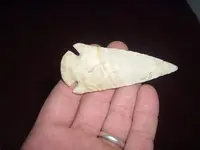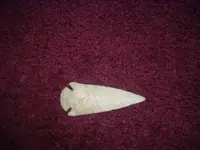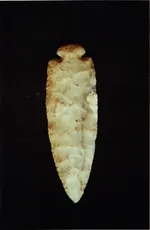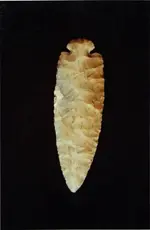You are using an out of date browser. It may not display this or other websites correctly.
You should upgrade or use an alternative browser.
You should upgrade or use an alternative browser.
FLEA Market FIND.
- Thread starter choo
- Start date
Stanfield/Cobbs blades are very likely to be finished pieces rather than preforms. The width to lenght ratio is much less on a Stanfield/Cobbs blade compared to a dove. If a culture were to make a dove from a Stanfield/Cobbs it would look like a lot of the grey ghosts floating around. The base would be much too wide. There are only a few examples of doves where the width to length ratio would be similar and that's on first stage, button base doves (i.e. Reinhart dove or Hooks dove.)
Moreover, most Stanfield/Cobbs blades show extensive resharpening and beveling suggesting they were either used as is or hafted with just the round base. Most likely both cases are true becasue some of them do have ground bases.
When looking at Stanfields/Cobbs, the basal flaking is usually much different than a dove. The flakes continue from one side to the other and they are rarely flaked from the base up. Usually there is only a light pressure retouch. Dove preforms were likely to be made into doves.
Most cultures used some form of round based knife and the biggest distinguising difference is the knapping style and bevelling often found on early archaic flint types. Also, most of the knapping on Stanfield/Cobbs blades is very similar to all early archaic types including hardins, thebes, and doves. All of those point types I've found on the same sites in Illinois and they were likely used by the same people for various differing reasons.
Hippy
Moreover, most Stanfield/Cobbs blades show extensive resharpening and beveling suggesting they were either used as is or hafted with just the round base. Most likely both cases are true becasue some of them do have ground bases.
When looking at Stanfields/Cobbs, the basal flaking is usually much different than a dove. The flakes continue from one side to the other and they are rarely flaked from the base up. Usually there is only a light pressure retouch. Dove preforms were likely to be made into doves.
Most cultures used some form of round based knife and the biggest distinguising difference is the knapping style and bevelling often found on early archaic flint types. Also, most of the knapping on Stanfield/Cobbs blades is very similar to all early archaic types including hardins, thebes, and doves. All of those point types I've found on the same sites in Illinois and they were likely used by the same people for various differing reasons.
Hippy
Amazon Forum Fav 👍
Th3rty7
Silver Member
Hippy said:Stanfield/Cobbs blades are very likely to be finished pieces rather than preforms. The width to lenght ratio is much less on a Stanfield/Cobbs blade compared to a dove. If a culture were to make a dove from a Stanfield/Cobbs it would look like a lot of the grey ghosts floating around. The base would be much too wide. There are only a few examples of doves where the width to length ratio would be similar and that's on first stage, button base doves (i.e. Reinhart dove or Hooks dove.)
Moreover, most Stanfield/Cobbs blades show extensive resharpening and beveling suggesting they were either used as is or hafted with just the round base. Most likely both cases are true becasue some of them do have ground bases.
When looking at Stanfields/Cobbs, the basal flaking is usually much different than a dove. The flakes continue from one side to the other and they are rarely flaked from the base up. Usually there is only a light pressure retouch. Dove preforms were likely to be made into doves.
Most cultures used some form of round based knife and the biggest distinguising difference is the knapping style and bevelling often found on early archaic flint types. Also, most of the knapping on Stanfield/Cobbs blades is very similar to all early archaic types including hardins, thebes, and doves. All of those point types I've found on the same sites in Illinois and they were likely used by the same people for various differing reasons.
Hippy
you lost me when you lumped Stanfield and Cobbs together, different culture and time period not to mention style of workmanship.
creek astronaut
Bronze Member
yea 37 i am in the same lost boat.We have gone from a questionable flea market find to "dovetail people" controlling the flint quarries in ohio to stanfields and cobbs blades being compared.makes for some entertaining reading.could be a fun night here on tnet 

joshuaream
Silver Member
- Joined
- Jun 25, 2009
- Messages
- 3,170
- Reaction score
- 4,512
- Golden Thread
- 0
- Location
- Florida & Hong Kong
LMAO!!!!Experts??This has been a great post and it all started at the flea market.lol.joshuaream,I got a few questions for you.What is your definition of a dovetail site??Have you ever found a Dovetail?Dovetail people,please explain that?And these "Dovetail people" controlled flint quarries??Where did you get this information?
[/quote]
Honkey,
Sorry for the delay, I was away on business and wanted to respond when I could post a picture or two.. The first two pictures are front and back of my best personal flint find. 5 3/4 inches of flintridge dovetail found along the eel river in Whitley County Indiana when I was about 9 or so. (Sorry for the sarcasm, but in case you don't don't see enough parallel flaking for your liking and doubt the authenticity, it's been pictured in GIRS and a few other places), can we see your best dove? I sold it when I was in high school, but plan on buying it again if it comes up for sale...
The questions in order-
Definition of a Dovetail site- That's the problem, there aren't any significant sites. Take any other significant point type from the Archaic and you can find multiple sites. (Dalton, Lecroy, Kirk, Lost Lake, etc.) Heck, there are more Cumberland sites out there than Dovetail sites and there are probably a 1000 authentic dovetails for every cumberland. Just to cover all the bases, as an example, a Kirk site is a site where Kirk/palmer points are found in a dateable context, with other artifacts, fire pits, etc. In the plow zone, where most of us hunt, earlier and later sites can/do get mixed up.
Have I found any dovetails- Aside from this one, I've been lucky enough to find several other doves between whole and brokes in Whitley and Allen Counties in Indiana and Van Wert, Ohio.
Dovetail people- People who originally made dovetails. Again, we know a lot about the people that made Kirk cluster artifacts, we know what they ate, how they hunted, how they buried their dead, what other tools they used, etc. We know the same about a lot of the Dalton Cluster, about the Cody Cluster, Lecroy people, etc. I think it's fascinating that we know very little about the people who made dovetails and related points (e-notch and thebes.)
Dovetail people controlling quarries- As Uniface put it, you don't see very many Kirks made from Flintridge and you don't see too many Dovetails in ohio made from crappy material. During the period when dovetails were made in Ohio, you rarely see other artifacts made from Flintridge, and it isn't until you get to the Adena and Woodland times that you see the same gem quality Flintridge quarries being used as frequently and spread over such a wide area.
Where did I get this- Not from reading Overstreets... Much of it comes from early work by Morgan and Prufer, and conversations with Noel Justice when I was in college. There is a great book call Archaic Societies, it's probably in your local library. Bob Cook at OSU did some of his earlier work on the Paleo to Archaic transition in the midwest, etc. There is a lot of material out there, it just takes reading through some occasionally very dry journals/books.
As far as caches, I've heard about the dovetail finds at the Olive Branch site, but haven't seen them. The Olive Branch site is so rich, that it's almost impossible to consider it a normal site (the quality and quantity of caches, and the size of the artifacts that have been found over the years is amazing.) In Ohio/Indiana, to my knowledge, there has never been a cache of dovetails mixed with Cobbs blades. As I mentioned before, there are un-notched dovetails out there, but they are built like dovetails not Cobbs blades. Attached is also a picture of a well used Cobbs blade, how would that have been notched to make a Dovetail? (Note, not my piece, the seller is imbus401 off eBay. I've bought from him before and he's a good seller.)
Enjoying the discussion,
Joshua
[/quote]
Honkey,
Sorry for the delay, I was away on business and wanted to respond when I could post a picture or two.. The first two pictures are front and back of my best personal flint find. 5 3/4 inches of flintridge dovetail found along the eel river in Whitley County Indiana when I was about 9 or so. (Sorry for the sarcasm, but in case you don't don't see enough parallel flaking for your liking and doubt the authenticity, it's been pictured in GIRS and a few other places), can we see your best dove? I sold it when I was in high school, but plan on buying it again if it comes up for sale...
The questions in order-
Definition of a Dovetail site- That's the problem, there aren't any significant sites. Take any other significant point type from the Archaic and you can find multiple sites. (Dalton, Lecroy, Kirk, Lost Lake, etc.) Heck, there are more Cumberland sites out there than Dovetail sites and there are probably a 1000 authentic dovetails for every cumberland. Just to cover all the bases, as an example, a Kirk site is a site where Kirk/palmer points are found in a dateable context, with other artifacts, fire pits, etc. In the plow zone, where most of us hunt, earlier and later sites can/do get mixed up.
Have I found any dovetails- Aside from this one, I've been lucky enough to find several other doves between whole and brokes in Whitley and Allen Counties in Indiana and Van Wert, Ohio.
Dovetail people- People who originally made dovetails. Again, we know a lot about the people that made Kirk cluster artifacts, we know what they ate, how they hunted, how they buried their dead, what other tools they used, etc. We know the same about a lot of the Dalton Cluster, about the Cody Cluster, Lecroy people, etc. I think it's fascinating that we know very little about the people who made dovetails and related points (e-notch and thebes.)
Dovetail people controlling quarries- As Uniface put it, you don't see very many Kirks made from Flintridge and you don't see too many Dovetails in ohio made from crappy material. During the period when dovetails were made in Ohio, you rarely see other artifacts made from Flintridge, and it isn't until you get to the Adena and Woodland times that you see the same gem quality Flintridge quarries being used as frequently and spread over such a wide area.
Where did I get this- Not from reading Overstreets... Much of it comes from early work by Morgan and Prufer, and conversations with Noel Justice when I was in college. There is a great book call Archaic Societies, it's probably in your local library. Bob Cook at OSU did some of his earlier work on the Paleo to Archaic transition in the midwest, etc. There is a lot of material out there, it just takes reading through some occasionally very dry journals/books.
As far as caches, I've heard about the dovetail finds at the Olive Branch site, but haven't seen them. The Olive Branch site is so rich, that it's almost impossible to consider it a normal site (the quality and quantity of caches, and the size of the artifacts that have been found over the years is amazing.) In Ohio/Indiana, to my knowledge, there has never been a cache of dovetails mixed with Cobbs blades. As I mentioned before, there are un-notched dovetails out there, but they are built like dovetails not Cobbs blades. Attached is also a picture of a well used Cobbs blade, how would that have been notched to make a Dovetail? (Note, not my piece, the seller is imbus401 off eBay. I've bought from him before and he's a good seller.)
Enjoying the discussion,
Joshua
Attachments
uniface
Silver Member
- Joined
- Jun 4, 2009
- Messages
- 3,216
- Reaction score
- 2,905
- Golden Thread
- 0
- Location
- Central Pennsylvania
- Primary Interest:
- Other
The business about the Dovetail makers controlling the best quarries/outcrops, and the division between them and the Kirk cluster people is taken from an overview of the Archaic era in (as I recall) Indiana written by an archaeologist maybe 20 or 30 years ago that I ran into googling around.
You could probably find a reference to it in another paper yourself in 15 minutes, tops.
You could probably find a reference to it in another paper yourself in 15 minutes, tops.
thirty7 said:Hippy said:Stanfield/Cobbs blades are very likely to be finished pieces rather than preforms. The width to lenght ratio is much less on a Stanfield/Cobbs blade compared to a dove. If a culture were to make a dove from a Stanfield/Cobbs it would look like a lot of the grey ghosts floating around. The base would be much too wide. There are only a few examples of doves where the width to length ratio would be similar and that's on first stage, button base doves (i.e. Reinhart dove or Hooks dove.)
Moreover, most Stanfield/Cobbs blades show extensive resharpening and beveling suggesting they were either used as is or hafted with just the round base. Most likely both cases are true becasue some of them do have ground bases.
When looking at Stanfields/Cobbs, the basal flaking is usually much different than a dove. The flakes continue from one side to the other and they are rarely flaked from the base up. Usually there is only a light pressure retouch. Dove preforms were likely to be made into doves.
Most cultures used some form of round based knife and the biggest distinguising difference is the knapping style and bevelling often found on early archaic flint types. Also, most of the knapping on Stanfield/Cobbs blades is very similar to all early archaic types including hardins, thebes, and doves. All of those point types I've found on the same sites in Illinois and they were likely used by the same people for various differing reasons.
Hippy
you lost me when you lumped Stanfield and Cobbs together, different culture and time period not to mention style of workmanship.
Stanfield and Cobbs blades are quite similar and many times I hear the names interchanged and used for both. Stanfield blades are early archaic as well and show a lot of the classic early archaic knapping traits seen on cobbs and points of the time.
Here's a link with a picture of a classic stanfield.
http://www.arrowheads.com/stores/detail.php?pid=NTgyMA==
Hippy
creek astronaut
Bronze Member
Joshuaream, Thats a monster dove.Very nice find.I, like you sold my only two complete doves. I sold my whole collection at that time 15 years ago,i regret that to this day but i really needed the money.I wish i had had the judgement to take a few pics.I do have many broken doves that i can take some pics of,i can assure you that 70% are relatively thin & well made,not thick and heavy with choppy flaking.I will get the pics up when i have a little more time.i have been hunting for 30 years in ohio/more specifically central ohio and have never bought a relic. I tend to base my opinions on my own experience & the experience of others that I have hunted with in the field.I do like reading and digesting differing theories and speculation,thats one of the things that makes our hobby so interesting and enjoyable,its always funner to disagree than to agree.lol.First,to speak about what started this post. I am always skeptical when it comes to store bought flint.Fakes have been being made for over a hundred years,i cant imagine how many fakes are in circulation.Fakes that not me,you or the best authenticator can call one way or the other.Doves are suppose to be a rare type but there seems to be alot of them being bought. I am willing to bet over 50 % of those in collections are fakes.jmo.
First the flint quarries.Example FlintRidge- The flint ridge quarries were not controlled by any specific culture or people it was nuetral ground thats what the experts say and i have to agree with them from what i have found in that area.Recent research by Ohio State University(1987,1988)and the Ohio Historical Society(1997,2003) archeaologist suggest that Archaic indians came to flint ridge to replace thier used and broken artifacts,not to produce large quanities of tools for trade.During recent excavations it was found that over half of the projectile points discarded at the ridge were made of other types of chert not ridge.No substantial Archaic settlements have ever been found on the ridge and it does not appear that any archaic group lived on the ridge and kept other groups from using the flint.I can back this up myself in a way,I have many different point types from the Early Archaic thru the Woodland period that are made of ridge and most were found within ten miles of the ridge.I will make a seperate post and show you the point type variety asap.
Dovetail people,Are you saying that these people only made doves?They would have to be to be classified as dovetail people.I can see different groups making a certain type to distinguish themselves from other groups but i really dont think they limited themselves to the point where we can class them as dove people.Thats my spin on it anyways imo I dont think ancient man would have limited himself to one tool/projectile type.I think they would have made whatever tool needed for the task at hand.I can kind of explain it this way,As a youth an individual may have made a dove for use as a knife and later in life that same individual made have prefered a thebes blade technology over the dove.Food for thought I guess.Maybe this is why there are not many dove specific sites on record??
I have to admit that I have limited myself to a degree to ancient ohio history but something stuck out to me that you commented on(burials).At least here in ohio no Early Archaic burials have ever been found because Early Archaic people did not bury the dead,the practice of cremation was much as it was for the paleoindian people.I will have to expand my reading I guess.
This has been a great thread.Goodluck hunting everyone.
First the flint quarries.Example FlintRidge- The flint ridge quarries were not controlled by any specific culture or people it was nuetral ground thats what the experts say and i have to agree with them from what i have found in that area.Recent research by Ohio State University(1987,1988)and the Ohio Historical Society(1997,2003) archeaologist suggest that Archaic indians came to flint ridge to replace thier used and broken artifacts,not to produce large quanities of tools for trade.During recent excavations it was found that over half of the projectile points discarded at the ridge were made of other types of chert not ridge.No substantial Archaic settlements have ever been found on the ridge and it does not appear that any archaic group lived on the ridge and kept other groups from using the flint.I can back this up myself in a way,I have many different point types from the Early Archaic thru the Woodland period that are made of ridge and most were found within ten miles of the ridge.I will make a seperate post and show you the point type variety asap.
Dovetail people,Are you saying that these people only made doves?They would have to be to be classified as dovetail people.I can see different groups making a certain type to distinguish themselves from other groups but i really dont think they limited themselves to the point where we can class them as dove people.Thats my spin on it anyways imo I dont think ancient man would have limited himself to one tool/projectile type.I think they would have made whatever tool needed for the task at hand.I can kind of explain it this way,As a youth an individual may have made a dove for use as a knife and later in life that same individual made have prefered a thebes blade technology over the dove.Food for thought I guess.Maybe this is why there are not many dove specific sites on record??
I have to admit that I have limited myself to a degree to ancient ohio history but something stuck out to me that you commented on(burials).At least here in ohio no Early Archaic burials have ever been found because Early Archaic people did not bury the dead,the practice of cremation was much as it was for the paleoindian people.I will have to expand my reading I guess.
This has been a great thread.Goodluck hunting everyone.

Similar threads
- Replies
- 10
- Views
- 1K
- Replies
- 11
- Views
- 941
Users who are viewing this thread
Total: 1 (members: 0, guests: 1)








